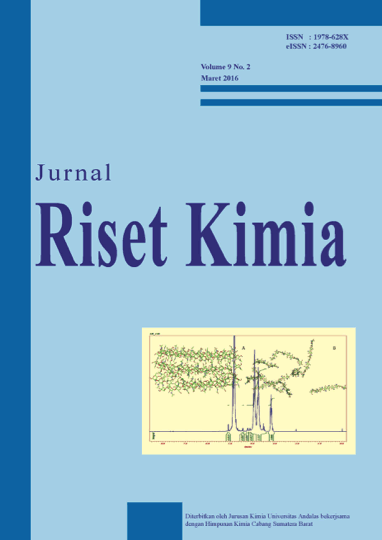ISOLASI DAN KARAKTERISASI METABOLIT SEKUNDER DARI EKSTRAK ASETON DAUN MACARANGA PRUINOSA BANGKA BELITUNG
DOI:
https://doi.org/10.25077/jrk.v9i2.248Keywords:
Euphorbiaceae, Macaranga pruinosa, flavanoneAbstract
Macaranga is a large genus in Euphorbiaceae, locally known as "Mahang-mahangan", and consisting about 300 species. Distribution of Macaranga is widespread from Africa and Madagascar in the west to the tropical regions of Asia including Indonesia. Based on previous research of the M. pruinosa, secondary metabolites that have been reported are flavonoid, and stilbenoid derivatives from Borneo. M. pruinosa that grow in South Sumatra produce poilanoat acid (diterpene). Therefore, this research is done to investigate phytochemical constituent of leaves of M. pruinosa from Bangka Belitung Islands. Isolation is done by maceration in acetone, separation and purification using vacuum liquid chromatography and radial chromatography. Structure determination were elucidated by 1H-NMR,13C-NMR, 2D NMR. Two compounds are identified as flavanon derivatives. They are nymphaeol B, and 6-farnesil-3',4',5,7-tetrahidroksiflavanon. These compounds are substituted with terphenyl group, known as geranyl (C10), and farnesyl (C15). Nymphaeol B (1) and compound of 6-farnesil-3', 4', 5,7-tetrahidroksiflavanon (2) have been found in other species of Macaranga. In conclusion, we here acquired two phenolic derivatives substituted by terphenyl groups from acetone extracts of leaves of M. pruinosa from Bangka Belitung. They are nymphaeol B, and 6-farnesil-3',4',5,7-tetrahidroksiflavanon. The result showed that M.pruinosa can produce different secondary metabolites depend on where they grow.
Â
References
Heyne, K., 1987, Tumbuhan Berguna Indonesia Edisi 2, Badan Penelitian dan Pengembangan Kehutanan, Departemen Kehutanan, Yayasan Sarana Wana Jaya.
Fareza, M.S., 2012, Aktivitas Antioksidan, Antibakteri, Dan Antijamur Senyawa Flavonoid dari Daun Macaranga adisca Zoli, Tesis Program Magister, Sekolah Pasca Sarjana, ITB, Bandung.
Ilmiawati, A., 2012, Flavanoid dari Daun Macaranga mappa (Euphorbiaceae) serta Aktivitas Antioksidan dan Sitotoksiknya, Tesis Program Magister, Sekolah Pasca Sarjana, ITB, Bandung.
Kawakami, S., Harinantenaina, L., Matsunami, K., Otsuka, H., Shinzato, T., dan Takeda, Y., Macaflavanones A-G, Prenylated Flavanones from the Leaves of Macaranga tanarius, Journal of Natural Products, 71(11), pp.1872–1876 (2008).
Mahendra, H., 2010, Asam Poilanoat dari Daun Macaranga pruinosa, Skripsi program S1, Institut Teknoligi Bandung.
Syah, Y.M., dan Ghisalberti, E.L., Phenolic Derivatives with an Irregular Sesquiterpenyl Side Chain from Macaranga pruinosa, Natural product communications, 5(2), pp.219–222 (2010).
Syah, Y.M., dan Ghisalberti, E.L., More Phenolic Derivatives with An Irregular Sesquiterpenyl Side Chain from Macaranga pruinosa, Natural product communications, 5(2), pp.45–49 (2012).
Tanjung, M., Hakim, E.H., Mujahidin, D., Hanafi, M., dan Syah, Y.M., Macagigantin, a Farnesylated Flavonol from Macaranga gigantean, Journal of Asian natural products research, 11(11), pp.929–932 (2009).
Tseng, M.H., Kuo, Y.H., Chen, Y.M., dan Chou C.H., Allelopathic Potential of Macaranga tanarius (L.) Muell.-Arg, Journal of Chemical Ecology, 29(5), pp.1269–1286 (2003).
Zakaria, I., Ahmat, N., Jaafar, F.M., Widyawaruyanti, A., Flavonoids with Antiplasmodial and Cytotoxic Activities of Macaranga triloba, Fitoterapia, 83(5), pp.968–972 (2012).
Downloads
Published
How to Cite
Issue
Section
Citation Check
License
Please find the rights and licenses in Jurnal Riset Kimia (J. Ris. Kim). By submitting the article/manuscript of the article, the author(s) agree with this policy. No specific document sign-off is required.
1. License
The use the article will be governed by the Creative Commons Attribution license as currently displayed on Creative Commons Attribution 4.0 International License.Â
2. Author(s)' Warranties
The author warrants that the article is original, written by stated author(s), has not been published before, contains no unlawful statements, does not infringe the rights of others, is subject to copyright that is vested exclusively in the author and free of any third party rights, and that any necessary written permissions to quote from other sources have been obtained by the author(s).
3. User Rights
Under the Creative Commons license, the journal permits users to copy, distribute, and display the material for any purpose. Users will also need to attribute authors and J. Ris. Kim on distributing works in the journal and other media of publications.
4. Rights of Authors
Authors retain all their rights to the published works, such as (but not limited to) the following rights;
- Copyright and other proprietary rights relating to the article, such as patent rights,
- The right to use the substance of the article in own future works, including lectures and books,
- The right to reproduce the article for own purposes,
- The right to self-archive the article,
- The right to enter into separate, additional contractual arrangements for the non-exclusive distribution of the article's published version (e.g., post it to an institutional repository or publish it in a book), with an acknowledgment of its initial publication in this journal.
5. Co-Authorship
If the article was jointly prepared by more than one author, any authors submitting the manuscript warrants that he/she has been authorized by all co-authors to be agreed on this copyright and license notice (agreement) on their behalf, and agrees to inform his/her co-authors of the terms of this policy. J. Ris. Kim will not be held liable for anything that may arise due to the author(s) internal dispute. J. Ris. Kim will only communicate with the corresponding author.












